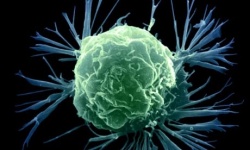DNA
A genomic test to predict chemotherapy outcomes
Although powerful, new, targeted treatments are regularly introduced to cancer clinics, choices for the first-line treatment of invasive breast cancer normally lie between preventive surgery and chemotherapy. A recent American study used genomic prediction combining multiple signatures to determine outcomes to standard chemotherapy.

Since the 1970s anthracyclines have remained the gold standard for efficacy in breast cancer, and chemotherapy regimens containing anthracycline consistently outperform those without it. However, not all tumours respond to this type of chemotherapy and several factors are known to influence outcomes including: tumour grade, p53 status, Topo II alpha level, HER2 over-expression, ER status and expression of multiple drug resistance (MDR).
A recent study from the University of Texas MD Anderson Cancer Centre [Hatzis C et al. A genomic predictor of response and survival following taxane-anthracycline chemotherapy for invasive breast cancer. JAMA. 2011 May 11;305(18):1873-81], used genomic prediction combining multiple signatures to determine outcomes to standard chemotherapy.
This multicentre study enrolled 310 women, newly diagnosed with Stages II and III invasive breast cancer. All were Her2 negative and received a chemotherapy regimen of sequential taxane and anthracycline, followed by endocrine therapy if ER-positive.
Gene expression microarrays were then developed from the neo-adjuvant breast tumours to develop different predictive signatures for drug resistance and response. These signatures were then used to predict response to chemotherapy in another, ‘independent’ cohort of 198 breast cancer patients with similar diagnosis and treatment in a validation process.
The primary endpoint was distant relapse-free survival (DRFS) if predicted treatment sensitive and absolute risk reduction (ARR), difference in DRFS between two predicted groups. Median follow up was three years. The 28% patients in the independent validation cohort, who were predicted to be treatment sensitive, had a 56% probability of an excellent pathological response, their three-year DRFS was 92%, ARR was 18% and they had a five-fold reduction of risk of distant relapse.
When the data were analysed by ER status, treatment sensitivity was predicted in 30% of the ER-positive women and in 26% of those who were ER-negative. At three year follow-up, in the ER-positive group DRFS was 97% and significant ARR was 11%. In the ER-negative subgroup DRFS was 83% and ARR 26%, the positive predictive value was 83%.
Interestingly, other genomic predictors showed paradoxically worse survival for patients predicted to be responsive to chemotherapy.
To guide the selection of a standard adjuvant treatment regimen, any test based on predicted response to treatment should expect a high probability of survival for those patients predicted to be treatment sensitive (negative predictive value, no relapse if predicted to be treatment sensitive) and a clinically meaningful survival difference between those patients predicted to be treatment sensitive and those predicted to be insensitive (ARR) as well as bettering results based on odds using existing clinical-pathological information.
According to the authors, the performance of this new test met these criteria in the independent validation cohort. If corroborated in future studies a test like this could perhaps, within as few as five years be guiding treatment choices in an individualised way for all women newly diagnosed with breast cancer.
Those patients who find that standard treatments are not useful for them could then be encouraged to enter clinical trials of new, alternative treatments early in the treatment ladder, when they will be most effective in enabling cure.
14.06.2011











